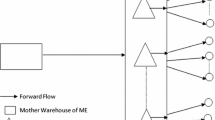Abstract
Enforced Legislations, social image, corporate citizenship and market competence are forcing manufacturing enterprises (MEs) to incorporate reverse logistics (RL) into their supply chains. RL can be used as a strategic tool to gain customer loyalty and reduce operational costs by maximizing recovery from used products. MEs face many issues which hinder successful implementation of RL such as lack of government support, financial limitations, capabilities and facilities, and market constraints. The situation is worse in case of MEs in developing countries and hence the collaboration of all its stakeholders is essential for handling the issue. Some earlier studies focused on investigating these issues and their solutions from company’s perspective without considering the role of the channel partners . To overcome this gap, this study proposes a collaborative framework for MEs which includes identifying the sustainable solutions for implementation of RL, prioritizing the solutions as per their importance and designing and optimizing a RL network based on the most important solutions identified. Decision Making Trial and Evaluation Laboratory (DEMATEL) approach is employed to understand the mutual relationships among the solutions and extract the most imperative solutions. The paper presents a linear programming problem for the RL network developed under a collaborative framework which aims to maximize the total sustainable impact in the planning horizon. The focus of the study is to optimally utilize the profit accrued from the returned products to generate funds for the NGO and company employees. A numerical illustration of the Indian electronic and electrical industry is presented to validate the proposed study.


Similar content being viewed by others
References
Dat LQ, Linh DTT, Chou S-Y, Yu VF (2012) Optimizing reverse logistic costs forrecycling end-of-life electrical and electronic products. Expert Syst Appl 39(7):6380–6387
Dwivedy M, Mittal RK (2012) An investigation into e-waste flows in India. J Clean Prod 37:229–242
Efendigil T, Onut S, Kongar E (2008) A holistic approach for selecting a third-partyreverse logistics provider in the presence of vagueness. Comput Ind Eng 54:269–287
Fleischmann M, Beullens P, Bloemhof-Ruwaard JM, Wassenhove LN (2001) The impact of product recovery on logistics network design. Prod Oper Manag 10(2):156–173
Fontela E, Gabus A (1976) The DEMATEL observer, DEMATEL 1976 Report. Battelle Geneva Research Center, Switzerland
Govindan K, Chaudhuri A (2016) Interrelationships of risks faced by third party logistics service providers: a DEMATEL based approach. Transp Res Part E Logist Transp Rev 90:177–195
Gunasekaran A, Spalanzani A (2012) Sustainability of manufacturing and services: investigations for research and applications. Int J Prod Econ 140(1):35–47
Hung Lau K, Wang Y (2009) Reverse logistics in the electronic industry of China: a case study. Supply Chain Manag Int J 14(6):447–465
Kiakojuri D, Shamshirband S, Anuar NB, Abdullah J (2015) Analysis of the social capital indicators by using DEMATEL approach: the case of Islamic Azad University. Qual Quant 49(5):1985–1995
Lozano R (2008) Developing collaborative and sustainable organisations. J Clean Prod 16(4):499–509
Manomaivibool P (2009) Extended producer responsibility in a non-OECD context the management of waste electrical and electronic equipment in India. Resour Conserv Recycl 53(3):136–144
Mutha A, Pokharel S (2009) Strategic network design for reverse logistics and remanufacturing using new and old product modules. Comput Ind Eng 56(1):334–346
Nagarajan V, Savitskie K, Ranganathan S, Sen S, Alexandrov A (2013) The effect of environmental uncertainty, information quality, and collaborative logistics on supply chain flexibility of small manufacturing firms in India. Asia Pacific J Mark Logist 25(5):784–802
Prakash C, Barua MK (2015) Integration of AHP-TOPSIS method for prioritizing the solutions of reverse logistics adoption to overcome its barriers under fuzzy environment. J Manuf Syst 37:599–615
Price waterhouse Coopers’ report (2008) Reverse logistics. http://www.pwc.nl/nl/publicaties/reverse-logistics.html [Accessed 20 Dec 15]
Ravi V, Shankar R (2015) Survey of reverse logistics practices in manufacturing industries: an Indian context. Benchmarking Int J 22(5):874–899
Rogers DS, Tibben-Lembke RS (1999) Going backwards: reverse logistics trends and practices, vol 2. Reverse Logistics Executive Council, Pittsburgh
Senthil S, Srirangacharyulu B, Ramesh A (2014) A robust hybrid multi-criteria deci-sion making methodology for contractor evaluation and selection in third-partyreverse logistics. Expert Syst Appl 41:50–58
Shieh JI, Wu HH, Huang KK (2010) A DEMATEL method in identifying key success factors of hospital service quality. Knowl-Based Syst 23(3):277–282
Srivastava SK (2008) Network design for reverse logistics. Int J Manag Sci 36:535–548
Srivastava SK, Srivastava RK (2006) Managing product returns for reverse logistics. Int J Phys Distrib Logist Manag 36(7):524–546
Thierry M, Salomon M, Van Nunen J, Van Wassenhove L (1995) Strategie issues in product recovery management. Calif Manag Rev 37(2):114–135
Tzeng GH, Chiang CH, Li CW (2007) Evaluating intertwined effects in e-learning programs: a novel hybrid MCDM model based on factor analysis and DEMATEL. Expert Syst Appl 32:1028–1044
Wath SB, Vaidya AN, Dutt PS, Chakrabarti T (2010) A roadmap for development of sustainable E-waste management system in India. Sci Total Environ 409(1):19–32
Wu WW (2008) Choosing knowledge management strategies by using a combined ANP and DEMATEL approach. Expert Syst Appl 35:828–835
Author information
Authors and Affiliations
Corresponding author
Rights and permissions
About this article
Cite this article
Agarwal, V., Govindan, K., Darbari, J.D. et al. An optimization model for sustainable solutions towards implementation of reverse logistics under collaborative framework. Int J Syst Assur Eng Manag 7, 480–487 (2016). https://doi.org/10.1007/s13198-016-0486-3
Received:
Revised:
Published:
Issue Date:
DOI: https://doi.org/10.1007/s13198-016-0486-3




